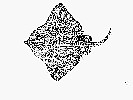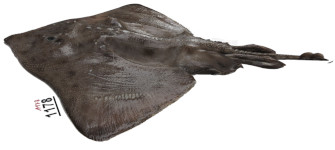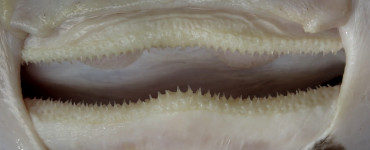Amblyraja hyperborea
(Collett, 1879)
Arctic skate
Classification: Elasmobranchii Rajiformes Rajidae
Reference of the original description
Fiske fra Nordhavs-Expeditionens sidste Togt, Sommeren 1878. Forhandlinger i Videnskabs–selskabet i Christiania, 1878, 14, 1–106
Fiske fra Nordhavs-Expeditionens sidste Togt, Sommeren 1878. Forhandlinger i Videnskabs–selskabet i Christiania, 1878, 14, 1–106
Image of the original description
.jpg)
Amblyraja badia (Garman, 1899), valid as <i>Amblyraja hyperborea</i> (Collett, 1879)
.jpg)
Amblyraja badia (Garman, 1899), valid as <i>Amblyraja hyperborea</i> (Collett, 1879)
Synonyms / new combinations and misspellings
Amblyraja badia, Amblyraja cf. hyperborea, Amblyraja robertsi, Raia badia, Raia borea, Raia hyperborea, Raja badia, Raja borea, Raja hyperborea, Raja robertsi, Raja (Amblyraja) badia, Raja (Amblyraja) hyperborea, Raja (Amblyraja) robertsi
Amblyraja badia, Amblyraja cf. hyperborea, Amblyraja robertsi, Raia badia, Raia borea, Raia hyperborea, Raja badia, Raja borea, Raja hyperborea, Raja robertsi, Raja (Amblyraja) badia, Raja (Amblyraja) hyperborea, Raja (Amblyraja) robertsi
Types
Amblyraja hyperborea
Holotype: ZMUO: J3134;
Amblyraja badia
Holotype: MCZ: 1008-S
Amblyraja robertsi
Holotype: ZMH: 25250 (old: ISH 54-1967);
Raja borea
Syntype: BMNH: 1887.12.9.4 BMNH: 1887.12.9.1 BMNH: 1887.12.9.2 BMNH: 1887.12.9.3
Amblyraja hyperborea
Holotype: ZMUO: J3134;
Amblyraja badia
Holotype: MCZ: 1008-S
Amblyraja robertsi
Holotype: ZMH: 25250 (old: ISH 54-1967);
Raja borea
Syntype: BMNH: 1887.12.9.4 BMNH: 1887.12.9.1 BMNH: 1887.12.9.2 BMNH: 1887.12.9.3
Description :
Citation: Amblyraja hyperborea (Collett, 1879): In: Database of modern sharks, rays and chimaeras, www.shark-references.com, World Wide Web electronic publication, Version 01/2026
Please send your images of "Amblyraja hyperborea" to info@shark-references.com

Amblyraja hyperborea (Collett, 1879), ERB 1178, male, 51, 2 DW, 67, 2 TL, France © Frederik H. Mollen (Elasmobranch Research Belgium)

Amblyraja hyperborea (Collett, 1879), ERB 1178, male, 51, 2 DW, 67, 2 TL, France © Frederik H. Mollen (Elasmobranch Research Belgium)
Common names
 Raya ártica,
Raya ártica,  Raie arctique,
Raie arctique,  Raie boréale,
Raie boréale,  Arctic skate,
Arctic skate,  Artic skate,
Artic skate,  Boreal skate,
Boreal skate,  Darkbelly skate,
Darkbelly skate,  Northern skate
Northern skate
 Raya ártica,
Raya ártica,  Raie arctique,
Raie arctique,  Raie boréale,
Raie boréale,  Arctic skate,
Arctic skate,  Artic skate,
Artic skate,  Boreal skate,
Boreal skate,  Darkbelly skate,
Darkbelly skate,  Northern skate
Northern skate
Short Description
Description after EBERT, 2014 [25436]: Field Marks: Disc subrhombic, with angular outer corners; tail short, tapering posteriorly. Snout moderately elongate, bluntly angled, and with stiff rostrum. Distinct enlarged thorns around orbits, mid–back, and scapular region; ventral surface smooth. Colour above dark grey or brown, occasionally with indistinct light spots and dark blotches; underside largely white only in juveniles, whereas dark speckling along midbody and along disc margins increasing with age and size with underside becoming predominantly dark. Diagnostic Features: Body disc of large specimens thick and somewhat flabby. Disc subrhombic, with anterior margins strongly undulated in mature males, and angular outer corners; tail short, stout at base, tapering posteriorly, with two small dorsal fins separated, or rarely confluent. Snout moderately elongate, bluntly angled, and vertically not flexible due to stiff rostrum to snout tip. Upper thorns distinct, set in largely constant pattern of separate orbital and supraspiracular thorns, a single one each on mid–nape and mid–shoulder, 2 to 3 on each shoulder, and a very regular median row of 25 to 32 thorns from anterior trunk to first dorsal fin; 0 to 2 thorns between dorsal fins, if these separated. All upper thorns large, their bases typically ribbed and with stellate margins, as well as those of thornlets; entire upper disc rough through large thorns, many thornlets scattered over snout and pectoral wings and coarse dermal denticles over most of disc and tail, but large specimens may lack thorns on pectoral wings and on trunk except for median thorn row; larger specimens may show rows of thornlets from anterior trunk onto anterior tail along each side of median thorn row; underside smooth. Colour: above dark grey or brown, occasionally with indistinct light spots and dark blotches; underside largely white only in juveniles, whereas dark speckling along midbody and along disc margins increasing with age and size, so that underside becomes predominantly dark.
Description after EBERT, 2014 [25436]: Field Marks: Disc subrhombic, with angular outer corners; tail short, tapering posteriorly. Snout moderately elongate, bluntly angled, and with stiff rostrum. Distinct enlarged thorns around orbits, mid–back, and scapular region; ventral surface smooth. Colour above dark grey or brown, occasionally with indistinct light spots and dark blotches; underside largely white only in juveniles, whereas dark speckling along midbody and along disc margins increasing with age and size with underside becoming predominantly dark. Diagnostic Features: Body disc of large specimens thick and somewhat flabby. Disc subrhombic, with anterior margins strongly undulated in mature males, and angular outer corners; tail short, stout at base, tapering posteriorly, with two small dorsal fins separated, or rarely confluent. Snout moderately elongate, bluntly angled, and vertically not flexible due to stiff rostrum to snout tip. Upper thorns distinct, set in largely constant pattern of separate orbital and supraspiracular thorns, a single one each on mid–nape and mid–shoulder, 2 to 3 on each shoulder, and a very regular median row of 25 to 32 thorns from anterior trunk to first dorsal fin; 0 to 2 thorns between dorsal fins, if these separated. All upper thorns large, their bases typically ribbed and with stellate margins, as well as those of thornlets; entire upper disc rough through large thorns, many thornlets scattered over snout and pectoral wings and coarse dermal denticles over most of disc and tail, but large specimens may lack thorns on pectoral wings and on trunk except for median thorn row; larger specimens may show rows of thornlets from anterior trunk onto anterior tail along each side of median thorn row; underside smooth. Colour: above dark grey or brown, occasionally with indistinct light spots and dark blotches; underside largely white only in juveniles, whereas dark speckling along midbody and along disc margins increasing with age and size, so that underside becomes predominantly dark.
Distribution
Northeast Atlantic: Spitsbergen to the Greenland-Iceland-Faroe-Shetland Ridge to northern Norway. Northwest Atlantic: Davis Strait between southwestern Greenland and Canada. Southeast Atlantic: southern tip of South Africa [1388]. Eastern Indian Ocean: off southern Australia [1388]. Southwest Pacific: New Zealand [1388]. Eastern Pacific: Costa Rica, Panama, Colombia, and Ecuador [1388]. Source: www.gbif.org
Northeast Atlantic: Spitsbergen to the Greenland-Iceland-Faroe-Shetland Ridge to northern Norway. Northwest Atlantic: Davis Strait between southwestern Greenland and Canada. Southeast Atlantic: southern tip of South Africa [1388]. Eastern Indian Ocean: off southern Australia [1388]. Southwest Pacific: New Zealand [1388]. Eastern Pacific: Costa Rica, Panama, Colombia, and Ecuador [1388]. Source: www.gbif.org
Human uses
fisheries: of no interest
fisheries: of no interest
Biology
Oviparous, paired eggs are laid. Embryos feed solely on yolk [733]. Distinct pairing with embrace. Young may tend to follow large objects, such as their mother [17086]; egg capsules measuring 81 to 125 mm by 54 to 77 mm, excluding the horns; surfaces are rather smooth in texture; egg case size varies with size of the female, as well as number of capsules laid [25436]. Found on the continental slope (Ref. 75154). Feeds on all kinds of bottom animals.
Oviparous, paired eggs are laid. Embryos feed solely on yolk [733]. Distinct pairing with embrace. Young may tend to follow large objects, such as their mother [17086]; egg capsules measuring 81 to 125 mm by 54 to 77 mm, excluding the horns; surfaces are rather smooth in texture; egg case size varies with size of the female, as well as number of capsules laid [25436]. Found on the continental slope (Ref. 75154). Feeds on all kinds of bottom animals.
Size / Weight / Age
TL (max): 107 cm TL; TL (mature): males/females: ~94 cm; TL (birth): 16 - 18 cm [25436]
TL (max): 107 cm TL; TL (mature): males/females: ~94 cm; TL (birth): 16 - 18 cm [25436]
Dentition
Tooth rows in upper jaw 35 to 48, teeth of larger specimens long and pointed and set in parallel rows. [25436]
Tooth rows in upper jaw 35 to 48, teeth of larger specimens long and pointed and set in parallel rows. [25436]
Remarks
shark-references Species-ID=207;
shark-references Species-ID=207;
Parasites (arranged by Jürgen Pollerspöck)
Monogenea
Nematoda
Copepoda
Monogenea
- Rajonchocotyle batis Cerfontaine, 1899 [17258]
Nematoda
Copepoda
- Schistobrachia ramosa (Krøyer, 1863) [17258]




























